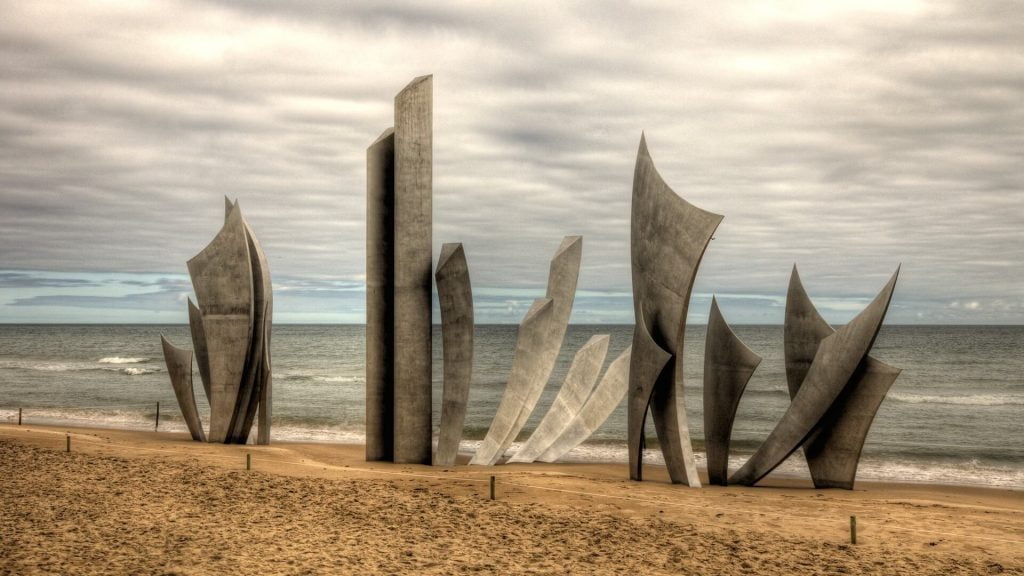Where are the Normandy landing beaches?
Content of the page
The Normandy Landing Beaches are located along the north-west coast of France. They lie between the towns of Caen and Cherbourg, and stretch for around 70 kilometres. The D-Day beaches are famous for their role in the Second World War, in particular D-Day, the day the Allies landed in Normandy on 6 June 1944.
Close to the Normandy landing beaches, you can stay in a charming hotel like Château de La Chenevière. Château de La Chenevière is an 18th-century manor house located in Normandy, between Bayeux and the D-Day landing beaches. It is a 5-star luxury hotel, voted Best Country Hotel by Small Luxury Hotels in 2020, Best Country Hotel in Europe by Condé Nast Johansens in 2019, and second Best Hotel in France and Monaco by Condé Nast Traveller in 2018. The Château also boasts a swimming pool, tennis court and heliport, as well as beehives and a permaculture vegetable garden that feed the work of the Chef in the two restaurants.
Utah Beach
The Normandy landing beaches are a series of coastal sites in France, on the north shore of the English Channel. They were the scene of the Allied landings during the Second World War on 6 June 1944, known as D-Day. The D-Day beaches are located in the department of Calvados, in the Normandy region.
Utah Beach was one of the five beaches of the Allied landings in Normandy on 6 June 1944, located south-west of the Seine Bay. It was the second beach to be overrun by the Allies, after Omaha Beach. The beach was named after the American state of Utah, whose American troops formed the bulk of the landing forces on the beach.
American troops landed on Utah Beach at 6.30am. The aim of the American troops was to capture the villages of Sainte-Marie-du-Mont and Sainte-Mère-Église, as well as to take control of the main road linking the two villages. One of the Americans' main strategic objectives was to prevent the Germans from reinforcing Omaha Beach.
Utah Beach was relatively easy for the American troops to take because of German mistakes and a series of favourable factors, including a low tide that allowed armoured vehicles to sail to the beach, and a light wind that made it more difficult for the Germans to spot and hit Allied ships with their shore batteries.
Omaha Beach
Omaha Beach was one of the five D-Day beaches in Normandy during the Second World War. It was one of the most important places to take during the D-Day invasion, as it was one of the few beaches where the Germans had concrete bunkers. Omaha Beach was also the main objective of the Americans.
The D-Day for Omaha Beach began at 6am on 6 June 1944. The first to land were the Rangers, who climbed the cliffs 100 feet above the beach. They then eliminated the German guns that could have caused major damage to ships and men.
Then it was the troops of the 29th American Infantry Division who landed on the beach. They were met by heavy fire from German bunkers and trenches. Many men were killed in the water or on the beach. The survivors found shelter behind anti-tank barriers and sand dunes.
With the help of tanks and artillery, the Americans managed to take control of the beach and advance inland. Despite the heavy losses, Omaha Beach was an important victory for the Allies.

Gold Beach
Gold Beach is one of the D-Day landing beaches in Normandy, France. It is one of five beaches in the British sector of the 1944 Allied landings, located between Omaha Beach to the north and Juno Beach to the south. The beach was part of the Allied Battle of Normandy designation code known as Gold, Sword, Juno and Utah, along with Omaha and Utah beaches.
Gold Beach was named for the colour of its sands, which are reminiscent of gold dust. The beach is 8 kilometres long and 150 to 200 metres wide. It is bordered by steep cliffs on the western side and protected by rocky shoals on the eastern side.
On 6 June 1944, D-Day, the 50th (Northern) Infantry Division landed on Gold Beach. The main objective of the 50th Division was to reach Arromanches-les-Bains and develop an artificial harbour (Mulberry B) to allow the landing of additional troops and equipment. The division also had to secure the flanks of Gold Beach by taking the villages of La Rivière and Le Hamel. The British troops then moved inland to join the other Allied divisions.
Today, Gold Beach is a popular tourist destination because of its eventful history. Many of the monuments memorials have been erected on the beach and in the surrounding area to pay tribute to the soldiers who fought and lost their lives here.
Juno Beach
Juno Beach was one of the five sites of the Allied landings in Normandy on 6 June 1944, known as D-Day. It was here that Canadian troops landed and began to advance inland, taking in the village of Courseulles-sur-Mer along the way. The beach was divided into three main areas - Mike, Nan and Roger - and was protected by anti-tank barriers and mines. The Canadians were the first to reach their assigned objectives on the beach, but at the cost of many lives. Today, Juno Beach is an important place of remembrance for Canada, and there are several Canadian monuments and cemeteries located in the area.
Sword Beach
Sword Beach is one of the Normandy landing beaches, located between Ouistreham and La Brèche de Roland. It is the beach where the British and Canadian troops landed on 6 June 1944.
Was Sword Beach a good beach for a landing?
Sword Beach was a good beach for a landing as it was relatively unprotected by natural obstacles and German fortifications. However, the beach was also exposed to fire from German shore batteries located to the east of the beach.
Ouistreham
Ouistreham is a French commune located in the Calvados department, in the Normandy region. The commune is known as the landing point for the Allies on 6 June 1944 during the Normandy Landings, also known as "D-Day".
On 6 June 1944, four American infantry divisions (two from the 1st US Army and two from the 3rd US Army) landed on the beaches of Utah and Omaha, as well as on the Channel Islands of Gold, Juno and Sword. The airport of Carpiquet was taken over by the British. The battle raged for several days and several thousand soldiers were killed.
The museum of the D-Day Landings and the Battle of Normandy, located in Ouistreham, retraces this historic event. The museum is open every day from 9am to 6pm.
Sainte-Marie-du-Mont
Sainte-Marie-du-Mont is on the north coast of France, in Normandy. The commune is part of the Calvados département, in the Normandy region. Sainte-Marie-du-Mont lies around 30 kilometres north-west of Caen, the department's capital.
The commune of Sainte-Marie-du-Mont is famous for being the site of the Allied landings on 6 June 1944, during the Second World War. The village was occupied by German troops. The Allies succeeded in taking the village and liberating the inhabitants.
Today, Sainte-Marie-du-Mont is an important place of remembrance and commemoration for the French and Americans. Every year, the commune welcomes many visitors who come to pay their respects to the soldiers who gave their lives for freedom.
The D-Day beaches in Normandy are now a popular tourist destination. Visitors can admire the remains of bunkers and fortifications built by the Germans during the Second World War. The D-Day beaches are also an ideal place to relax and enjoy the natural beauty of the Normandy coast.
Arromanches-les-Bains Colleville-sur-Mer
Arromanches-les-Bains is a commune in the French department of Calvados, in Normandy. The commune is located around 10 kilometres north-west of Caen and around 180 kilometres north-west of Paris. Arromanches-les-Bains is best known for being one of the sites of the Normandy landings during the Second World War.
On 6 June 1944, Arromanches was the landing place for Allied troops on the beach known as Gold Beach. It was here that the Allies built an artificial harbour to land the troops and equipment needed to liberate Europe. Today, you can still see the remains of this artificial harbour, which has become a symbol of freedom regained.
Colleville-sur-Mer is a commune in the French department of Calvados, in Normandy. The commune is located around 10 kilometres north-west of Caen and around 180 kilometres north-west of Paris. Colleville-sur-Mer is best known as the burial place of the famous American soldier Theodore Roosevelt Jr, son of the 26th President of the United States. United States.
Theodore Roosevelt Jr. was killed on 6 June 1944, during the Normandy landings. He was buried at Colleville-sur-Mer American Cemetery, where 9,387 other American soldiers killed during the Second World War are also buried. The Colleville-sur-Mer American cemetery is a very important place of remembrance for the United States and a symbol of the friendship between the two countries.
Discovering the D-Day landing beaches in Normandy is a unique experience. These places are steeped in history and significance, and offer a beautiful view of the sea. If you're looking for an interesting and rewarding holiday destination, this is the place for you.



